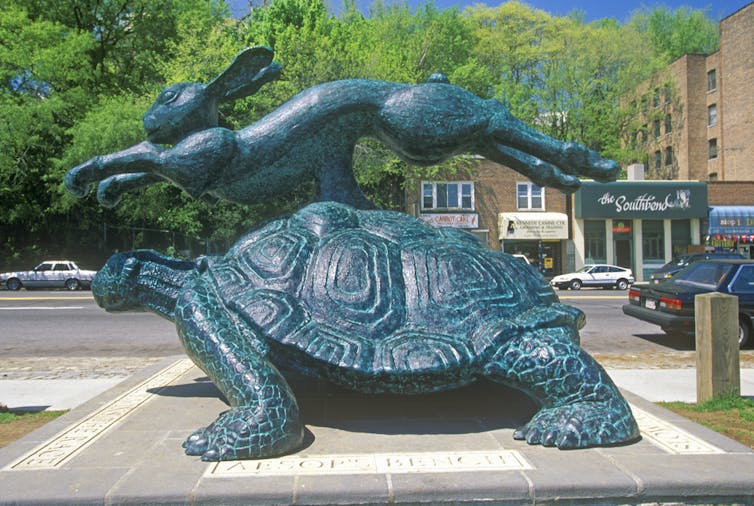January 15, 2018
As research scientists, we read a lot of scientific papers. But it may surprise you to learn that a lot of the time we – yes, we scientists – don’t understand what we’re reading, or we’re too bored to remember what we’ve just read.
Peer-reviewed papers are the currency of science. They are the basis upon which knowledge is recorded and traded. They are our stamps of approval and they keep us employed. In short, research papers are our bread and butter.
But our buttered bread can be difficult to digest; typically, it is bloated, dense and so dry that no amount of chewing can make it tasty.
So we decided to do something about it. We wrote a paper about writing papers, explaining why and how it’s important for scientists to change the way we write.
Our paper is centred around one key character: Ingredient X.
Read more: Mainstream is not a dirty word
Ingredient X
Ingredient X is that substance people rarely talk about or teach in science writing, or rarely come across. But when you do see it, complex concepts are readily absorbed, sentences skip along the page rather than plod, facts pique interest rather than disengage, and the scientific message is remembered rather than forgotten.
Ingredient X is creativity and clarity, it is the use of narrative and tangible prose. It is the reader that is the priority of Ingredient X, not the writer.
Here’s what we as scientists can do to achieve Ingredient X:
1. Get our heads out of the sand
Scientists are trained to be objective and focus on their field of research – they are not trained to think about the reader at the other end absorbing their information. Others have recognised this problem, and we need to address it.
2. Break the cycle
Let’s value writing more in science. Writing is not just a means to an end to describe the facts and figures, but an integral part of it. Writing should be a craft that we hone, rather than homogenise. We need to break the cycle of miscommunication that assumes everyone wants dry, stodgy bread: in reality, who likes that?
3. Reward good writing
If we value good writing, we will then promote and reward good writing. This can be everyone’s job, from those at the coalface (e.g. supervisors, authors, reviewers and journal editors) to those a little further away (e.g. universities, government agencies and science societies).
4. Stop teaching the “Official Style”
We write science in the “Official Style” (elegantly defined in Lanham’s classic style manual) because it is entrenched in us from the ground up. Let’s take a fresh look at how we teach science writing, with a focus on reader engagement and readability.
5. Read and write more
Scientists should be encouraged to read and collect good writing and learn from it, to start working out what makes good writing good. And there are some good style manuals to guide us along the way (check out citations in this article as a start). Scientists do write a lot, but we do need to write differently more often, and with an open mind.
Read more: Listen up: a plan to help scientists get their research heard by decision makers
Be concise, original, inspiring
But let’s be clear. We are not advocating sensationalism. Scientists are wary of sensationalism and for good reason. Science is about facts and objectivity, not hyperbole to sell a story.
However, we maintain that objectivity is not at odds with adding a creative element to our writing, or making it clearer, more accessible and interesting to read.

Inspired by Aesop’s The Tortoise and the Hare, consider the following hypothetical science article title:
The different locomotory response of mammalian (Lepus) and reptilian (Testudo) taxa to interspecific competition
This title meets the scientific criteria of being accurate and objective. But it’s also non-emotive, formal, impersonal and jargony. Does interspecific competition really pique your interest here?
If the title is rewritten with a sensationalist angle, we might end up with:
The new dinosaur age! Reptiles win the race
While this is concise and entertaining, it is sensationalist, oversimplified and hyperbolic. Most scientists would find such a title professionally unsuitable.
The happy medium is what we call the “future culture”, a title that is accurate, objective, concise and clear, but also inspiring, original and accessible:
The locomotory edge: how a slow and steady gait benefits the most unlikely of species
The traditions of science writing
Traditional scientific writing is often boring and hard to read. Why? Actually, we’re not sure. It’s just the way it is, it is the way it has always been, and it seems to be getting worse.
Most people in science seem to think everyone else wants us to write in the way that we do. And if we try to write any other way, it’s our experience that this is typically stamped as inappropriate.
But here’s the real problem: if scientists find it hard to read papers, people from the non-research world who want to read about our science will find it even harder.
Science communicators, journalists, entrepreneurs, policymakers and interested members of the general public are all motivated to follow the latest scientific research. And yet, strangely enough, science papers are a communication tool but they are not that effective at communication.
We are in the “Knowledge Age”, where knowledge is more diverse and accessible than ever, but most of our knowledge remains cloistered. We work in a profession that champions change and re-evaluation, but scientific writing sits stagnant.
So that’s our story about writing, science, and why we should be taking Ingredient X in both hands and giving it a go.
We’re now back at our desks writing with renewed vigour: devouring what we can about writing, teaching Ingredient X to those that are keen, and actually enjoying what we write.
Written by:
Research Fellow, University of Adelaide
Professor, Ecology, University of Adelaide
Originally published at The Conversation.


